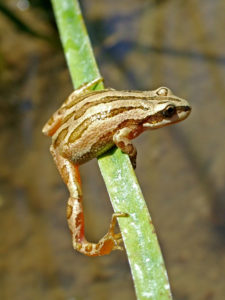By Debra Patla
The tiny Boreal Chorus Frog owns the natural soundscape of Jackson Hole wetland areas during mild weather in May and early June. Each male chorus frog sends out a trill, lasting about one second and repeated 30 or more times per minute. Each responds to the calling of its near neighbors, filling the acoustic space. Warm, moist evenings are peak performance times, with hardly a break in the continuous concert that is audible a half-mile away or more. Hard to believe these frogs are barely one inch long!
Nature Mappers, be aware that you can discern one, two, or three chorus frogs calling, but more than that confuses the ear. For a continuous chorus, all you can do is make a guess about the number and make a note about it.
A male chorus frog clams up when he succeeds in finding a female attracted to the pool by the compelling concert. Climbing on the back of the typically larger female, he wraps his front legs around her, just behind her front legs. There he clings until she excretes a clutch of eggs, which he fertilizes externally. When that’s over, he may yet have time to rejoin the chorus and find another mate.

The Boreal Chorus Frog is given away by its vocalizations in the spring and early summer. It’s harder to actually catch a glimpse of one.
As summer approaches, the chorus becomes faint…solo frogs, not chorus frogs! And then, finally, silence. In that silence, much is going on. The adults migrate to summer hunting grounds in moist upland areas. The egg clusters they left behind, attached to underwater stems, hatch into tiny tadpoles that feast and rapidly grow in their forest of aquatic vegetation. Completing metamorphosis in July or early August, the little frogs emerge from the water and move upland like their parents. If all goes well, they can survive 5-7 years, returning each spring to wetlands to breed.
Two other native species in Jackson Hole have a somewhat similar life history, the Columbia Spotted Frog and the Western Toad. But their spring silence is a striking difference. One needs to be at exactly the right place and time to hear the males arguing or calling softly to females.
With luck, you will see or hear a frog or toad, or many of them, this summer. An identification guide is available at: http://www.wyomingbiodiversity.org/application/files/4015/9113/4646/AmphibianGuide_Small.pdf.
Please be sure to Nature-Map your sightings!

